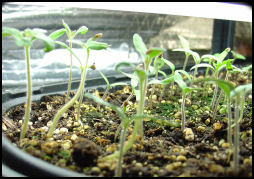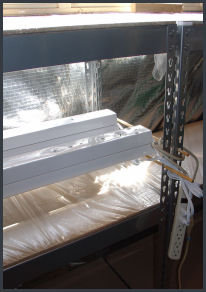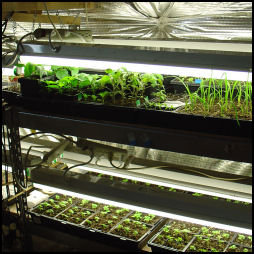





Why start from seed? You might be tempted by the photos in the seed catalogs that fill your mailbox in January. You may want to grow wonderful heirloom vegetables that just aren't available in your local garden centers. You could decide it's more cost effective to start flats of plants from seed than to buy them outright. But I think the best reason to start plants from seed is that it's just such fun! From seed to garden specimen is a magical process, and it's enchanting to watch it unfold. Making this magic happen inside, however, requires LIGHT...
Although generations of gardeners have started seeds on sunny windowsills, the seedlings often end up tall and spindly. If you want flats of sturdy seedlings, but you don’t have a greenhouse, a light shelf is the way to go.
Sunny windowsills aren’t really as bright as they look, compared to outdoor sunshine. If you’re starting plants inside, artificial light is a big help. You can purchase wonderful shelf units with expensive grow lights, and they will certainly work. But you can get the same results on a much more slender budget.
Seedlings don’t need full spectrum lights; the cool fluorescent tubes in a cheap shop light are fine. A fixture with two 48 inch fluorescent tubes will provide enough light for two standard nursery flats (1020 size) of seedlings. It’s important to set up the light so that the height can be adjusted to keep the light just an inch or two from the top leaves of the seedlings as they grow. If you use a bookcase or storage shelf unit, you can hang a light over a shelf on adjustable chains or ropes. Just hang the fixture from the next shelf up (or from the ceiling for the top shelf). A useful knot to know for adjusting ropes is the taut-line hitch. 
The fluorescent lights that most of us are used to seeing are T-12s, which use 40 watts of electricity per 48 inch tube. There are some newer fluorescent lights on the market now, and I especially like the slim 32 watt T-8 tubes. Their electronic ballasts don't flicker, making the light seem brighter and cleaner to me. I also appreciate having just a little extra clearance when my tomato seedlings start reaching for the sky. The T-8 tubes and fixtures are a bit more expensive than the T-12’s, but the difference is partially offset by the energy savings.
If you want the most bang for your buck, the 48 inch tubes and fixtures are the most cost effective for the home grower. If your space is limited, fluorescent tubes do come in other sizes. Fixtures that take two 24” tubes should be easy to find and will provide enough light for a single flat of plants. Fluorescent fixtures and tubes are manufactured in a variety of sizes for the aquarium trade, but these can be costly unless you find them secondhand. The cheapest solution is usually to find a space where you can rig up a 48 inch shop light or two.
Plant stands and shelves also come in a range of sizes and prices. The Propagation Forum has had some wonderful threads on DIY plant stand plans. Here’s a link to a discussion of making plant stands from PVC pipe. If you need to keep pets or children away from dangling wires and delicate seedlings, try enclosing your shelves with screen panels.
My light shelves are set up using Gorilla RackTM units that have metal uprights with holes for adjustable supports for 48x18 inch shelves. It turns out that I can put a quarter inch wooden dowel through those holes and use the dowels to support my shop lights. To change the height of the lights, I just move the dowels to a different set of holes.
Your seedlings need at least 12 hours of light each day. Some people have good results running lights 24/7 for their seedlings. I usually run my lights for 16 hours on, 8 hours off. Putting your lights on a timer definitely simplifies things. Be sure to use a heavy duty timer that will take a 3 pronged plug. Using that third prong to ground the lights is important for electrical safety, so please don’t take shortcuts. Similarly, any extension cords you use should be heavy duty ones with 3 prong (grounded) connections. If you can connect it to a GFI outlet, so much the better. If you have any concerns, consult a licensed electrician.
By May, I usually have 20 to 24 flats of plants under lights in the basement. That may be more space than you care to devote to seed starting, but anybody can find space to start a flat or two of plants. I’ve heard of people putting flats on top of cabinets, raising them close to fluorescent office lights by stacking bricks under them. I recall one creative DGer who put a shop light across the rungs of two kitchen chairs and set a flat of plants underneath the chairs, on the floor. My first light shelf was set up in our utility room, over the washer and dryer. 
Putting together shelves and hanging lights isn’t as exciting as playing in the dirt. But you’ll be so glad to have your seed starting space all set up and ready to go when it’s time to sow seeds.
Clear a space for a seed starting nook or a corner shelf, or make room for an entire bank of seed starting shelves. Rig adjustable fluorescent lights above each shelf, and put them on a timer. If you can, make space for one or two extra flats of plants. Once you start sowing and transplanting, your space will fill up faster than you’d believe!
In the next Seed Starting article, I'll discuss heat mats – what they are, why they are useful, and some DIY alternatives to those sold in nursery catalogs.
Edited May 2010 to add to the list of my seed starting articles below for easy reference.
Seedling Heat Mats and Inexpensive Alternatives
The Dreaded Damping-Off (and How to Prevent It)
Seed Starting 101: Sowing Seeds and Clump Transplanting for Sturdy Seedlings
Seed Starting 101: Hardening off Seedlings Before Planting Out in Your Garden
Seed Starting 101: Planting Out - Tips for Transplanting Seedlings into Your Garden
Seed Starting 101: Growing Peppers from Seed
Seed Starting 101: Grow the Best Tomatoes Ever from Seed
Copyright © www.100flowers.win Botanic Garden All Rights Reserved